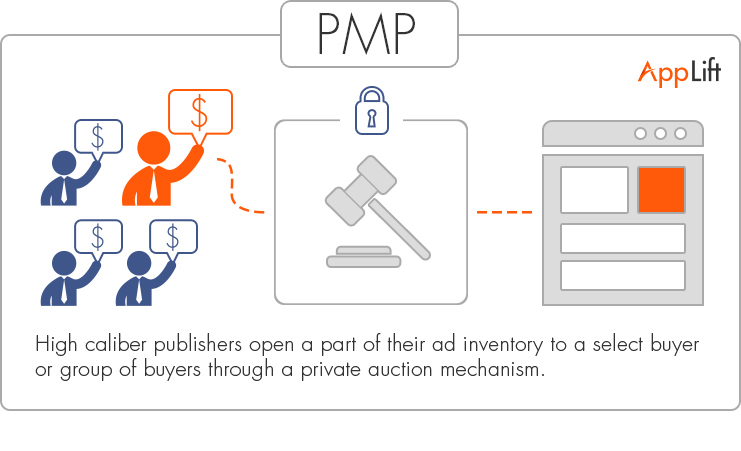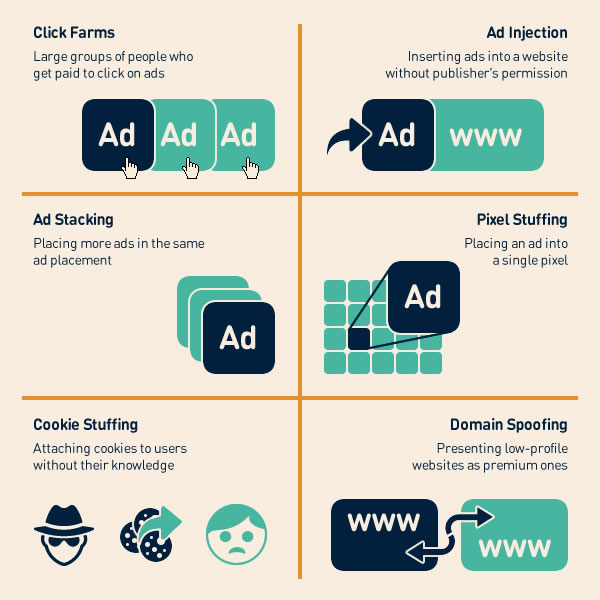At a quick glance, it’s hard to pinpoint the downside to programmatic advertising on the open marketplace. In exchange for your budget, you get unparalleled access to countless internet users in the spaces they frequent, in contexts that boost the odds of conversion. So why, then, are advertisers shifting their dollars from the open exchange to private marketplaces?
What is a private marketplace?
A private marketplace (PMP) refers to a digital marketplace where advertising is bought and sold programmatically between exclusive parties. As opposed to the open marketplace, where all advertisers have access to inventory across the web, private marketplaces are invite-only environments where publishers offer premium ad space to quality advertisers:

Why are private marketplaces getting more popular?
With such widespread access to potential buyers, it’s hard to imagine an advertiser pulling budget from the open marketplace. But it’s happening. According to eMarketer, private marketplace deals will account for the majority of programmatic spend by this year:

And from there, the gap will only widen. According to PubMatic, private marketplace spending will grow at double-digit rates through 2021. A closer look at programmatic shows the reason for the shift: The open marketplace is rife with potential for ad fraud and branding disaster. Estimates of budgetary losses to ad fraud range from 5.8 billion to 42 billion in 2019:


The disparity is a result of how different firms detect and assign dollar values to fraudulent impressions. No matter how you look at it, says Nicole Perrin, Principal Analyst at eMarketer, “marketers are throwing billions of dollars away.”
So, how do fraudsters steal billions of dollars? With several methods: They can simulate traffic or steal an impression for themselves, using bots or crawlers to fake human behavior. They can spoof domains and other methods:

Click spamming, for example, generates an enormous number of clicks that look like they’re from real devices. Another technique, called click injection, can create fake clicks while apps are installed.
Last year, Facebook sued app developers LionMobi and JediMobi for using click injection to steal revenue. In a blog post, Jessica Romero, Director of Platform Enforcement and Litigation at Facebook, shared how they tried to do it:
The developers made apps available on the Google Play store to infect their users’ phones with malware. The malware created fake user clicks on Facebook ads that appeared on the users’ phones, giving the impression that the users had clicked on the ads.
In 2016, a similar but even more convoluted case ended with an estimated 36 million ad dollars stolen when a company called Methbot used several methods to commit fraud: fake clicks, social media logins, geolocations, and dedicated servers to disguise its origin. Later, a scheme called 3ve would emerge from Methbot’s, and result in another lost $29 million. Stories like these are not uncommon:

But the fraudsters aren’t always third-party hackers looking to make a quick buck. Even publishers have been found guilty of nefarious practices similar to the ones hackers employ. They’ll use clickbots and in some cases or rely on hidden ads, which a publisher will charge for, but display in a window that’s invisible to the user. This allows them to sell more ad space than they have. Another way to do this is by selling the same space to multiple advertisers and piling ads on top of each other so that only one is visible to users.
The benefits of private marketplace advertising
Though private marketplaces are only for select inventory and brands, and may not make up a significant portion of an advertiser’s strategy, there are some major benefits to using them:
The benefits to publishers
- Publishers can maintain the efficiency of programmatic without the risk. Instead of relying on a sales team to close a traditional deal, they can connect with buyers as they would on the open marketplace, but with more emphasis on safety.
- Of course, brand reputation is among the highest benefits for publishers. If they can control who is bidding on their inventory, they can ensure their placements are always filled with quality advertisements from reputable brands.
- With PMP advertising deals, publishers can ensure they get paid top dollar for their premium placements. On the open marketplace, the highest bidder doesn’t always win the auction, and PMPs are a great way of making sure money isn’t left on the table for publishers.
- With PMP advertising, brands are in a better position to share their first-party data than on the open marketplace, where numbers and metrics can be muddled or restricted in ways that hinder advertiser choices and the user experience.
The benefits to advertisers
- Like publishers, advertisers too benefit from the efficiency that PMPs offer. Instead of relying on a human team to broker deals with publishers, they can purchase space with a demand-side platform as they would on the open marketplace.
- Publishers aren’t the only ones who need to be concerned about brand safety. More than once, brands have been surprised to find their advertisements embedded in violent and extremist content. When they know who they’re buying inventory from, and where it’s going, advertisers can be sure their brand won’t suffer a reputational hit.
- When inventory on the open marketplace doesn’t go to the highest bidder, advertisers lose too. If an advertiser is willing to bid more for an impression, that’s because that impression is more valuable to that advertiser. To award that placement to a lower bidder is to rob the publisher of revenue, the advertiser of an impression and potentially a conversion.
- By getting publisher data directly from the source, advertisers can make more informed decisions about their messaging, placements, formats, and more. And better decisions for advertisers usually translates to more relevant ads for consumers.
PMP advertising isn’t resistant to fraud
Despite their exclusive nature, PMPs are not immune to ad fraud. Though they’re more regulated, they are still at risk for fraudulent behavior their parties can’t detect. And according to Paul Harrison, Manager of Business Intelligence at White Ops, that behavior is more prevalent than you’d expect, mostly due to advancements in bots that mimic traffic.
Today’s bots look much more human than the bots of even three years ago. Today over 75% of botnet traffic is operated from residential human machines, running in the background, entirely unbeknownst to the machine’s rightful owner.
Instead of being robotic, botnets now piggyback on existing malware-infected computers, mimic human behaviors, and reverse engineer detection solutions. They can copy IP addresses, browsing times, cookies, mouse movements, keystrokes, and more.
The result is that PMPs buys are now just as susceptible to fraud as non-PMP ones. Research from White Ops uncovered that 40% of domains had more fraud on private buys than outside PMPs.

That said, it’s important to remember that ad fraud is notoriously difficult to measure. Numbers like these shouldn’t be taken as fact.
Additionally, it’s safe to say that even if publishers in private marketplaces are susceptible to certain kinds of fraud, it’s less likely to be the kind committed by publishers. With higher quality publishers and inventory come higher standards of operation.
Are you as likely in a private marketplace, with a select group of advertisers and publishers, to fall victim to domain spoofing or ad stacking? Odds are, no. For publishers, the answer can be ad fraud detection. For advertisers, it’s important to ask partners in a private marketplace what they’re doing to prevent ad fraud. When premium inventory and top dollar is on the line, publishers should be doing everything they can to keep fraudsters away.
Create high quality landing pages for PMP advertising
If you’re generating high-quality traffic through private marketplaces, the worst thing you can do is direct them to a generic landing page. When users click your ad, they should arrive on a landing page personalized to them, which matches the ad, and maintains relevance throughout the campaign.
To do that, you need a landing page for every audience. And the only way to accomplish that is with the Advertising Conversion Cloud™. Sign up for an Instapage 14-day free trial today.

Try the world's most advanced landing page platform with a risk-free trial.
